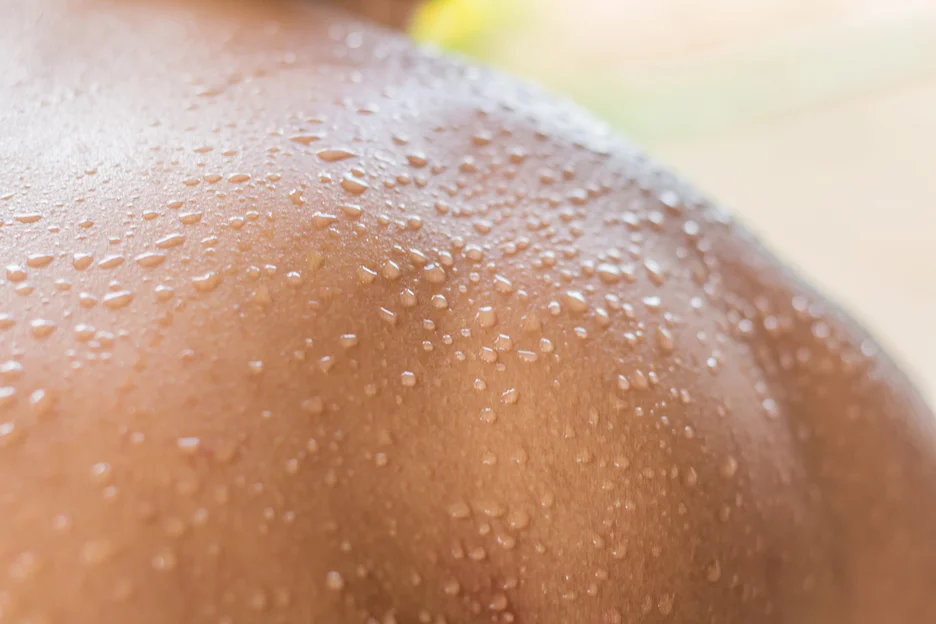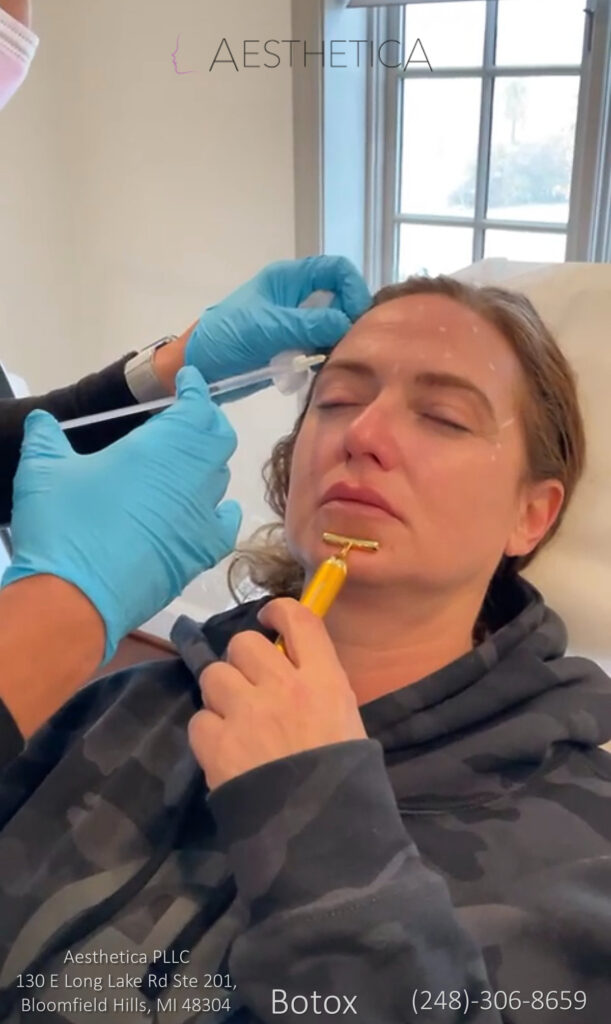
About 15 million people around the world experience hyperhidrosis or excessive sweating. Often, this condition goes undiagnosed and gets mistaken for normal sweating. Patients complain about excessive sweating even in cold temperatures, and situations where one is unexpected to sweat. To treat this condition, doctors can recommend Botox injections in the concerned areas.
So what are the side effects of using Botox for treating excessive sweating? The side effects commonly associated with Botox use are redness, swelling, pain, and bruising. Specifically for treating hyperhidrosis, patients may experience numbness or even partial paralysis in the areas where the botulinum toxin A was injected. Patients can expect a high efficacy rate leading to immediate and lasting relief from their symptoms.
Aesthetica can assist you with all your beauty needs, helping you achieve your maximum beauty and aesthetic potential. Call or contact us today to learn more about our cosmetic services.
As with any other medical procedure, patients run the risk of experiencing some side effects. Botulinum toxin type A or Botox injections can also trigger some unwanted adverse effects. Oftentimes, these side effects are minor and disappear on their own without intervention.
But there may be instances of more serious or severe side effects that require immediate medical attention, especially if done by inexperienced providers. For best results, go to a reliable med spa or aesthetic center. Meanwhile, some side effects of botox injections for sweating are listed below:
| Minor Side Effects | Serious Side Effects |
| Swelling Redness and irritation Pain and tenderness in injection areas Headache and nausea Constipation Flu-like symptoms Bruising Compensatory sweating | Trouble breathing (tightness of chest, shortness of breath) Severe muscle weakness/paralysis Difficulty breathing (shortness of breath or tightness of chest) Vision impairment (Blurred vision) Loss of bladder control Throat blockage Allergic reactions |
The most common side effects of using Botox for treating hyperhidrosis would be redness, bruising and tenderness, or mild pain in the injected areas. Patients can expect these to resolve on their own after a few days. In addition, muscle weakness can occur in the same areas.
Because Botox is a neurotoxin, the body may have a natural immune system response to it. Patients may experience flu-like symptoms which can include headaches, constipation, and nausea. However, the side effects should be mild to moderate and gradually disappear over the next few days or weeks.
In treating hyperhidrosis, botox is injected directly into areas where sweating occurs such as the armpits. Patients may expect to feel some sort of numbness or paralysis in the areas that have been injected with botox. In some rare cases, compensatory sweating is experienced when patients cease to sweat in the areas that were treated, but the patients begin to sweat in areas where they previously did not experience sweating.
Common side effects listed above are rarely life-threatening, however, if the symptoms persist for long, it may be best to seek medical attention as this can mean that the body may not be receiving the neurotoxin well.
Although cases, where patients experience serious side effects, are very rare, they may still pose a life-threatening risk when encountered. Severe rashes, dizziness, and other signs of allergic reactions are signs that the body is having an extremely adverse reaction to the toxin.
Vision problems, difficulty breathing, and loss of bladder control may be indicators that the toxin has traveled to unwanted and unintended areas. This can be a cause for concern and patients should call their doctor immediately for medical attention.
Botox treatment is considered less invasive as compared to surgical procedures. A Botox injection can cause minimal pain as the needles go only through the surface of the skin. Botulinum toxin is known to be safe and effective. However, botox treatment may be expensive costing about $1000 per procedure, while needing a follow-up botox injection every 7 to 16 months.

Hyperhidrosis is a condition where patients experience abnormal and excessive sweating that isn’t related to heat or physical activity. Often, the sweating that occurs is disruptive to a patient’s lifestyle, which makes it a cause for concern. This can cause social anxiety and embarrassment in those who experience its symptoms.
Sweating is the nervous system's response to different stimuli. Body temperature rises because of these stimuli and the brain decides to cool the body off through sweating. Patients with hyperhidrosis have overactive nerves that send a lot of signals causing excessive sweating to occur.
Botox injections stop the neurotransmitter acetylcholine from binding to sweat glands and signaling sweat production. When body temperature rises, the nervous system normally activates the sweat glands. This is how your body cools down on its own. The nerves that signal the sweat glands are overactive in persons with hyperhidrosis.
The hyperactive nerves are effectively blocked when patients receive Botox injections directly into the area of the body where sweating occurs the most. In principle, the body will not sweat if the nerves can't communicate with the sweat glands. Botox only works to stop sweating in the area where it's injected.
Following Botox injections, patients can immediately resume their normal activities. It takes 2 to 4 days to notice the effects, and 2 weeks for the injections to fully take action. Botox's effects are temporary so patients will need further injections in the future.
Booster injections for underarm perspiration are usually required every 7 to 16 months. Results may not last as long for the hands and feet, and treatment may be repeated after about 6 months.
Hyperhidrosis symptoms include excessive sweating in areas such as the forehead, armpits, feet, and others. Overactive sweat glands in these areas lead to unwanted sweating even under cool or relaxed conditions.
There is no medical cause for hyperhidrosis, and it’s believed to be hereditary. However, secondary hyperhidrosis happens as a side effect of other medical conditions. It’s uncommon, but the following medical conditions may trigger overactive sweat glands.
In addition, recovering drug addicts may experience excessive sweating and develop hyperhidrosis as withdrawal settles in. In these cases, botox injections are not recommended as the underlying cause is more treatable and symptoms may be more temporary.
There are some things patients can do at home to remedy the adverse effects of hyperhidrosis. First, patients can try stronger antiperspirants that contain aluminum-based compounds which temporarily block the pores. This reduces the amount of sweat that is produced.
Over-the-counter topical astringents containing tannic acid can help relieve some of the symptoms. Bathing daily can also rid the body of bacteria that builds up from sweat. Patients may also opt to wear clothes specifically designed for more airflow and moisture-wicking.
Available treatment options include prescription antiperspirants, botox treatments, nerve-blocking medications, and surgery. Doctors may prescribe aluminum chloride antiperspirants that are administered to the affected areas. However, this may make patients more prone to skin irritation. Hydrocortisone creams may be more helpful for inflamed and irritated skin.
Botulinum toxin A is an effective treatment option for hyperhidrosis. This treatment option works by blocking the nerves that cause sweating. Each affected area will receive several injections and the effects last for about 6 to 12 months before treatment needs to be repeated.
Meanwhile, surgical options include sweat gland removal and sympathectomy, or nerve surgery. A minimally invasive technique called suction curettage can be done to remove the sweat glands in the patient's armpits. For nerve surgery, surgeons cut and clamp spinal nerves that trigger sweating in the concerned areas. This option is more complicated as the nervous system is delicate.
Another treatment option is microwave therapy where a device delivers microwaves to effectively damage the sweat glands so that they become inactive. Treatments often last 20 to 30 minutes per session every 3 months. This option is expensive and not widely available.
Patients should seek medical attention when they experience disruption from their daily activities. In some cases, excessive sweating can get in the way of a patient's daily routine and may make it hard for them to go about their day normally.
Patients who experience social anxiety and depression should also seek medical advice in order to combat the symptoms as soon as possible. Besides talking to a doctor for treatment of the symptoms, it may be good for patients to seek counseling or support to cope with and understand their conditions better.

Hyperhidrosis is excessive sweating in unwanted areas that cause disruption to a person’s daily activities. Botulinum toxin type A or Botox is often used to treat this condition because the neurotoxin blocks the nerves that signal the sweat gland to produce sweat. Side effects of this kind of treatment are often mild and resolve on their own.
For a full assessment and treatment prescription of your conditions, Aesthetica is your go-to physician-led medical spa. Aesthetica is well-equipped with cutting-edge technology, and our team is highly qualified for a range of medical procedures. Botox treatments, as well as derma fillers, facials, and others available in our spa. You can reach them here.
Aesthetica can assist you with all your beauty needs, helping you achieve your maximum beauty and aesthetic potential. Call or contact us today to learn more about our cosmetic services.